Sign up for our Newsletter
Please fill out the following:
2012 Volume
January 9, 2012
For a downloadable version, click the following:
About that Labor Force Participation Rate pdf
About that Labor Force Participation Rate
The monthly national employment numbers are posted by the U.S. Department of Labor's Bureau of Labor Statistics [typically] on the first Friday of the month with the preceding month's data. In recent newsletter articles, we have focused on a particular aspect of the Bureau's Employment Report figures, namely the Labor Force Participation Rate. The Labor Force Participation Rate is a ratio of those people, 16 and older either employed or unemployed as percent of the Civilian Noninstitutional Population.
Lies, Damned lies, and Statistics
December 5, 2011
www.econnewsletter.com/dec052011.html
Labor force Participation Rate
The labor force participation rate represents the proportion of the civilian noninstitutional population that is in the labor force. This measure of labor force activity grew from about 60 percent nationally in 1970 to about 67 percent in 2000, with much of the increase resulting from increased participation by women.
In a week or so, we will be presenting a deeper look into the labor force participation rate and how it impacts the overall employment picture. In the meantime, we'll analyze the current data based on the Employment Report from Friday, January 6, 2012.
…looking pretty rosy
THE EMPLOYMENT SITUATION – DECEMBER 2011
U.S. Department of Labor, Bureau of Labor Statistics
January 6, 2012
bls.gov/news.release/pdf/empsit.pdf
Nonfarm payroll employment rose by 200,000 in December, and the unemployment rate, at 8.5 percent, continued to trend down, the U.S. Bureau of Labor Statistics reported today. Job gains occurred in transportation and warehousing, retail trade, manufacturing, health care, and mining.
Both the number of unemployed persons (13.1 million) and the unemployment rate (8.5 percent) continued to trend down in December. The unemployment rate has declined by 0.6 percentage point since August.
Commissioner's Statement on the Employment Situation – DECEMBER 2011
U.S. Department of Labor, Bureau of Labor Statistics
January 6, 2012
www.bls.gov/news.release/pdf/jec.pdf
Nonfarm payroll employment rose by 200,000 in December, and the unemployment rate, at 8.5 percent, continued to trend down. In 2011, payroll employment growth averaged 137,000 per month. Private-sector job gains totaled 212,000 in December and 1.9 million over the year. Government employment changed little over the month but fell by 280,000 over the year.
The labor force participation rate, at 64.0 percent, was unchanged in December, but was slightly lower than a year earlier (64.3 percent).
ahh, but not so fast…let's dig into the Labor Force Participation Rate:
- In January 2009, the Civilian Labor Force stood at 154,185,000. By December 2011, the Civilian Labor Force had fallen by 298,000 to 153,887,000 people.
- In January 2009, the Civilian Noninstitutional Population stood at 234,739,000. By December 2011, the Civilian Noninstitutional Population had risen by 5,845,000 to 240,584,000 people.
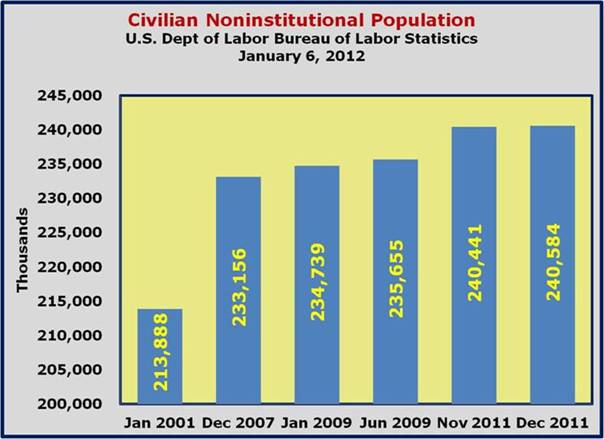
- The Labor Force Participation Rate in January 2009 was 65.68% and by December 2011 the Labor Force Participation Rate had fallen to 63.96%.
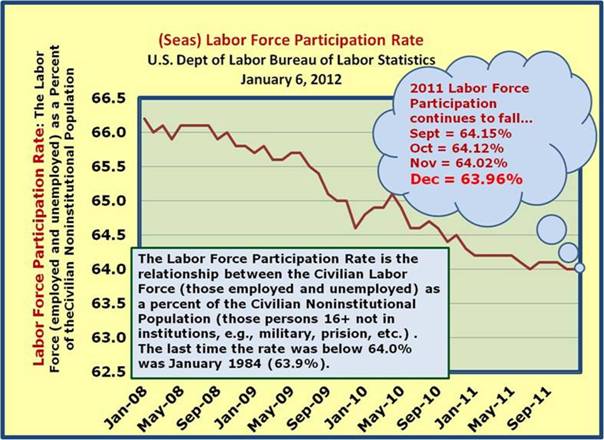
- Adjusting for a Labor Force Participation Rate of 67% (of the Civilian Noninstitutional Population of 240,584,000), the Civilian Labor Force should be 161,191,000 or 7,304,000 higher!
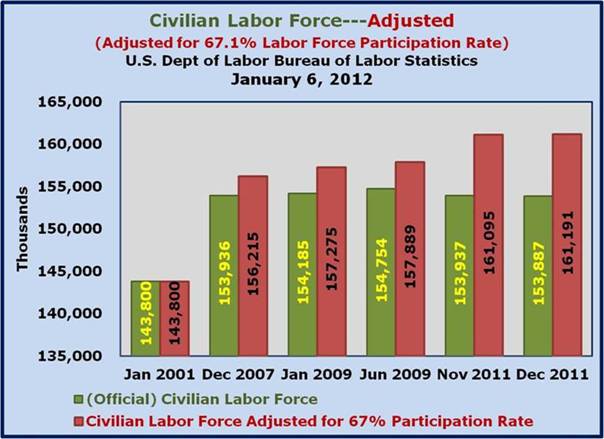
What does this mean?
If a 67% Labor Force Participation Rate is more realistic than the current 63.96% Labor Force Participation Rate, then the 'Unemployed' are understated by 7,304,000 people, so rather than 13,097,000 unemployed the adjusted number would be 20,401,000!
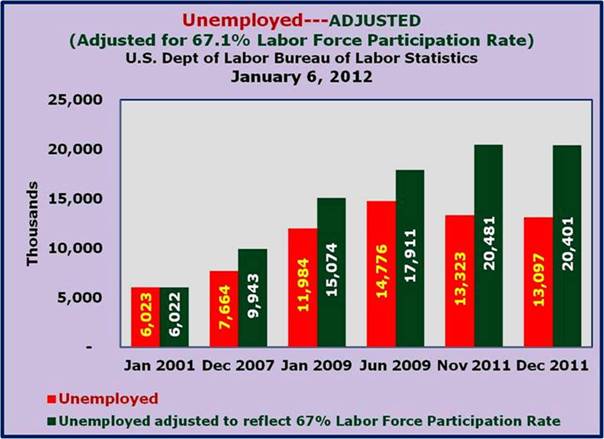
Taking this a step further, the unemployment rates would also be adjusted upward.
The U-3, or official rate came in at 8.5% for December 2011. The U-3 unemployment rate adjusted for the 67% Labor Force Participation Rate would come in at 13.3%, the same rate as November 2011.
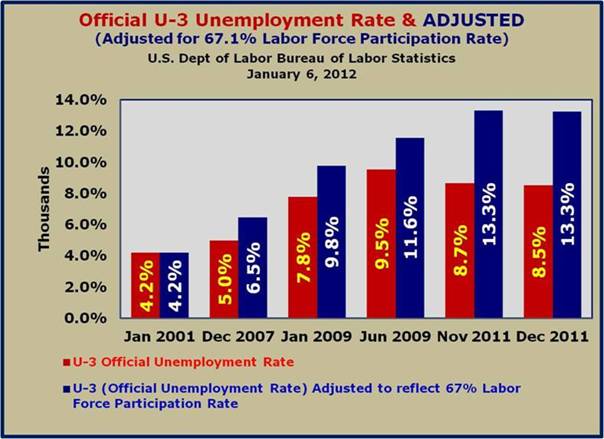
Finally, the U-6, or alternative unemployment rate that includes "total unemployed, plus all persons marginally attached to the labor force, plus total employed part time for economic reasons, as a percent of the civilian labor force plus all persons marginally attached to the labor force" came in at 15.2% for December 2011. The U-6 unemployment rate adjusted for the 67% Labor Force Participation Rate would come in at 19.9%.
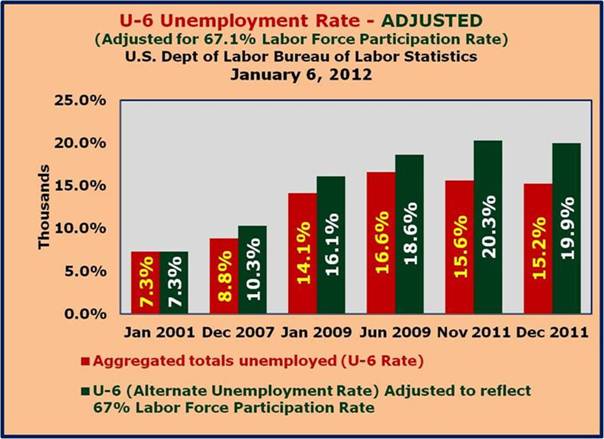
In our next look at the Labor Force Participation Rate – we'll get it out in a week or two – we will drill down on the numbers and try to ferret where the persistent problems are and what the prognosis is going forward. As we pointed out in a previous newsletter article:
Lies, Damned lies, and Statistics
December 5, 2011
www.econnewsletter.com/dec052011.html
The major cause of this decline in the participation rate has been the discouraged worker effect exacerbated by an unprecedented duration of unemployment. Spikes in the early retirement rate and the permanent disability rate have also added to this decline.
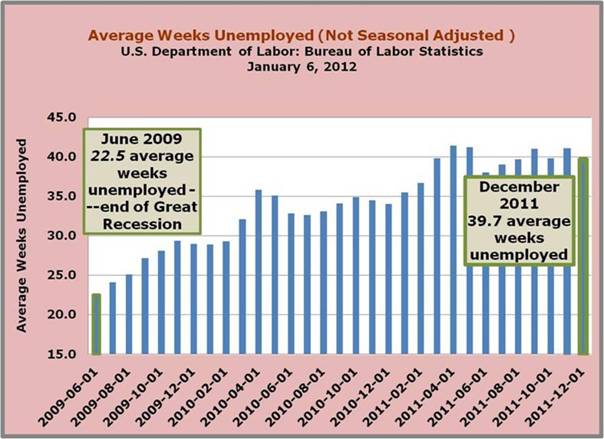
While the factors mentioned have certainly played a role in driving down the Labor Force Participation Rate, we suspect it has more to do with what we term the extremely discouraged worker – those people who have given up on any hope of seeking employment given the current and ongoing abysmal economic environment.


